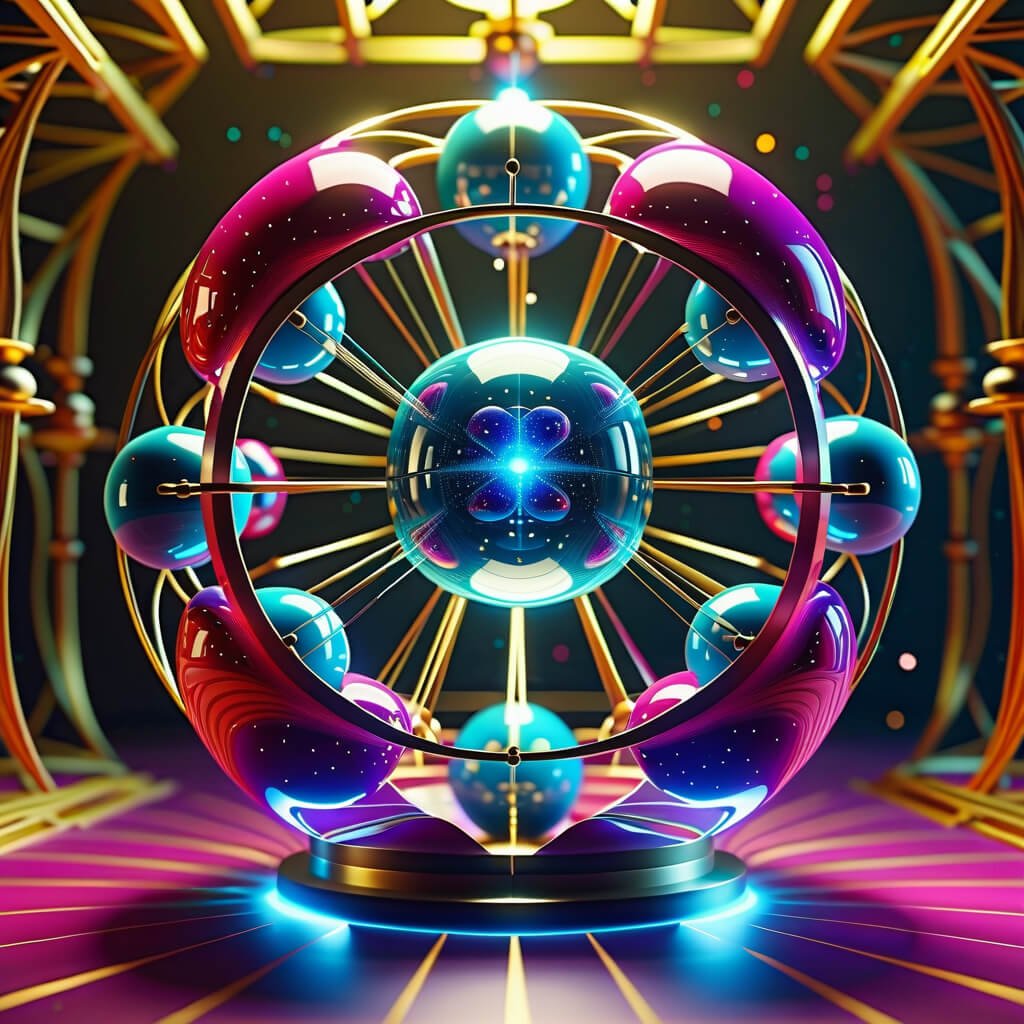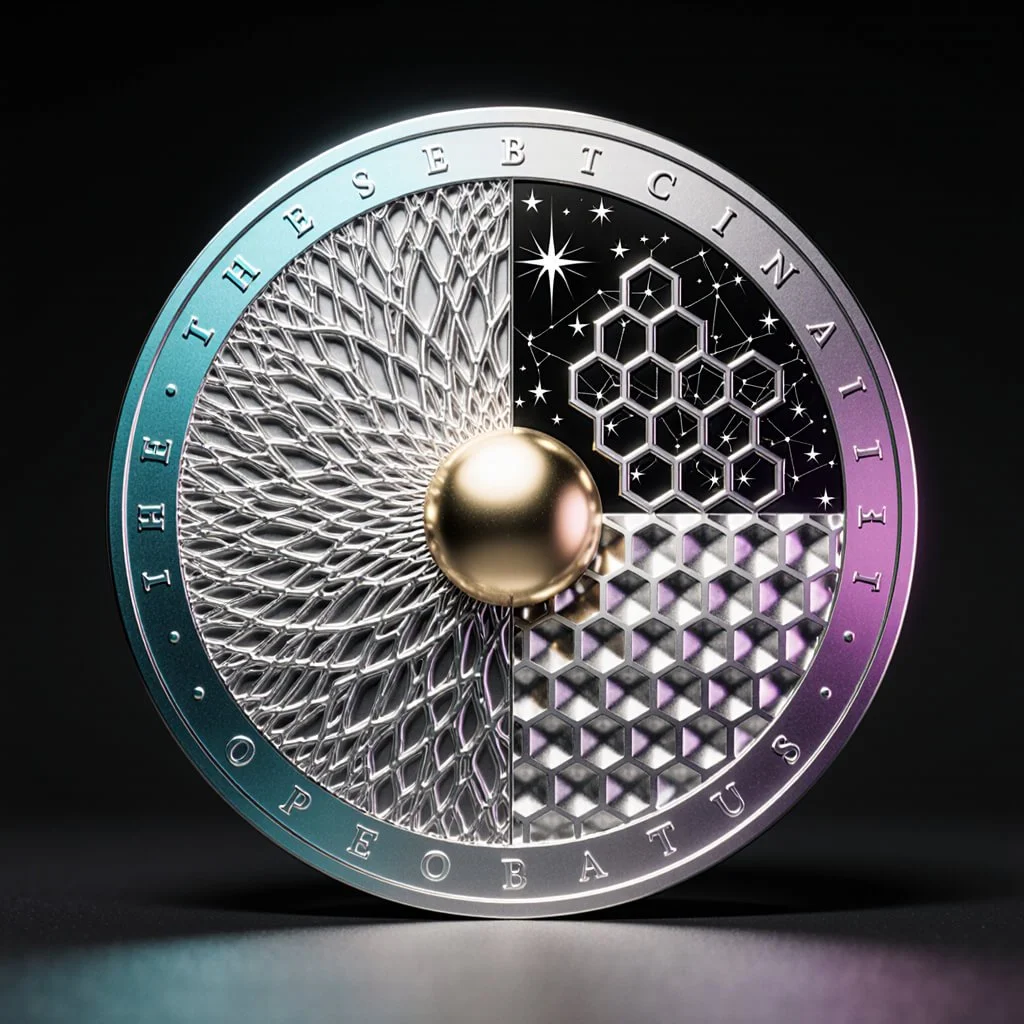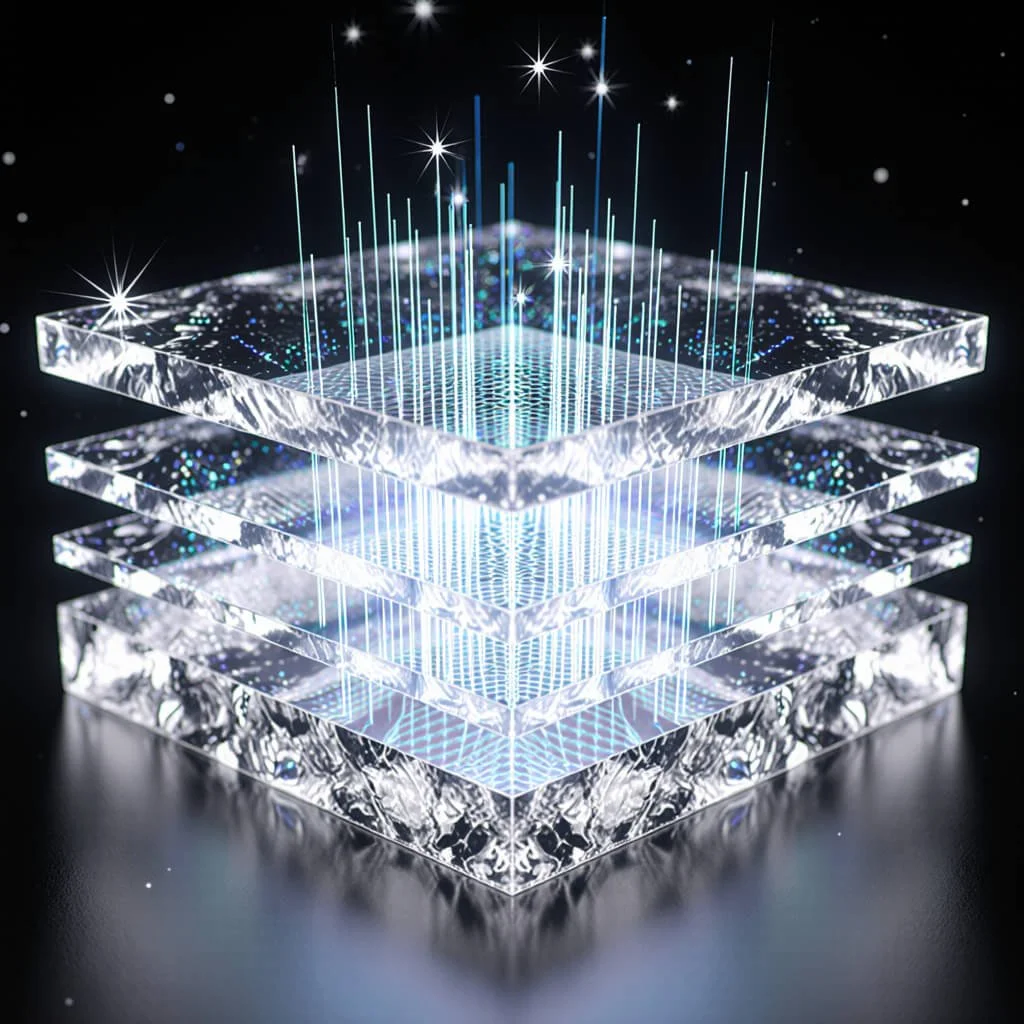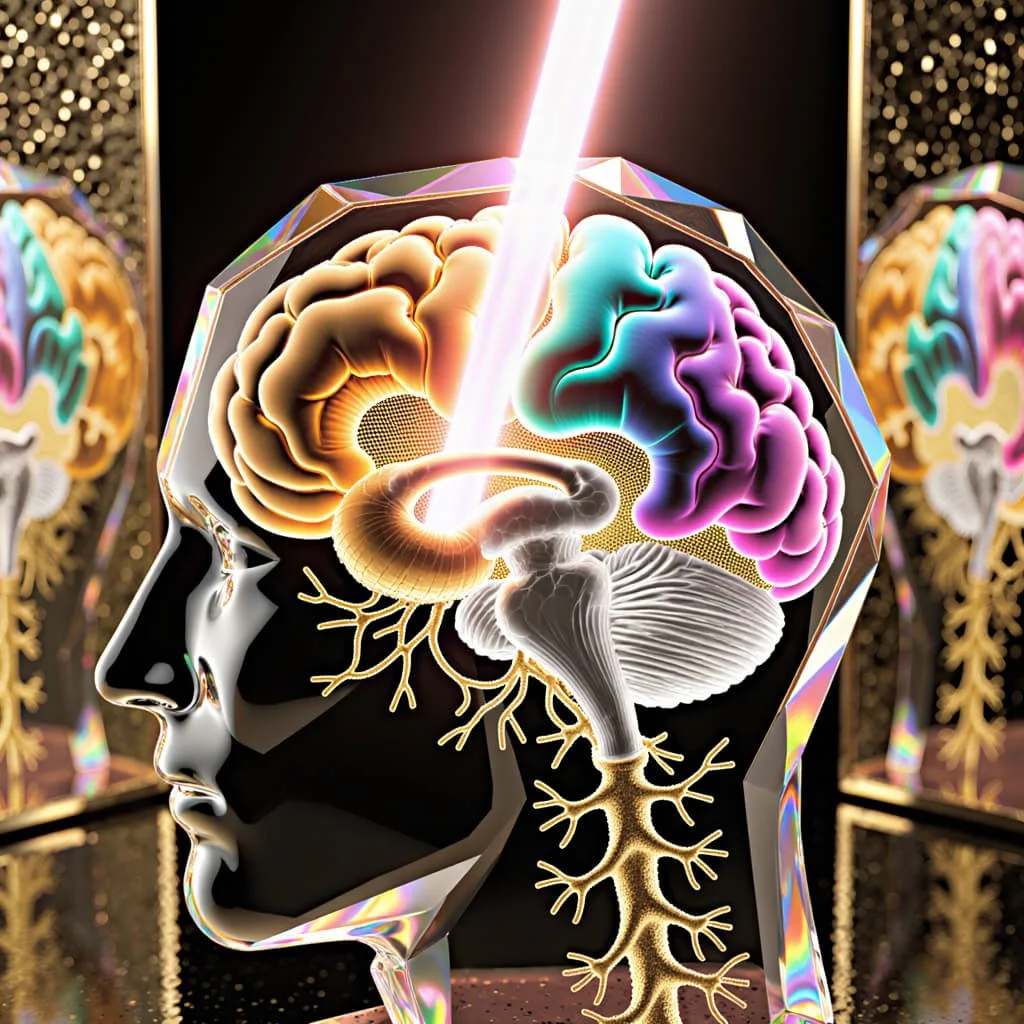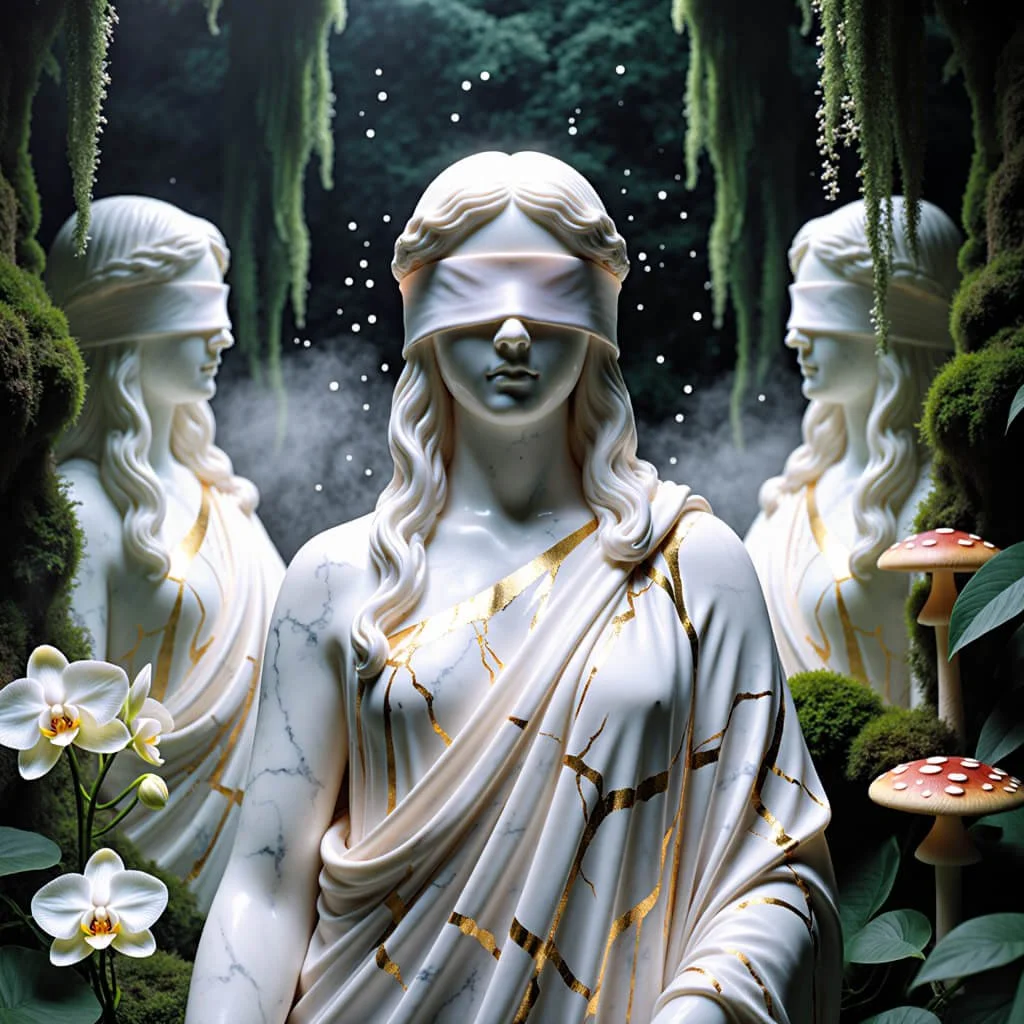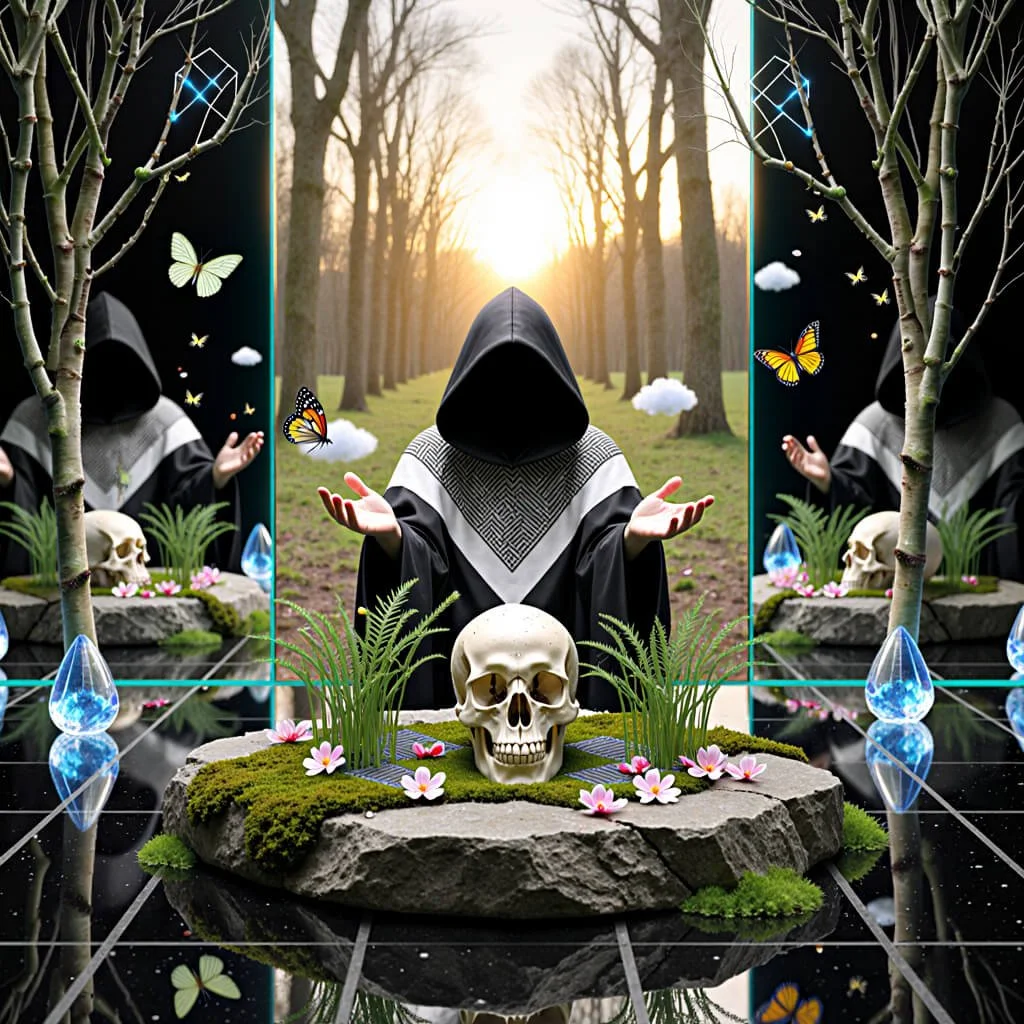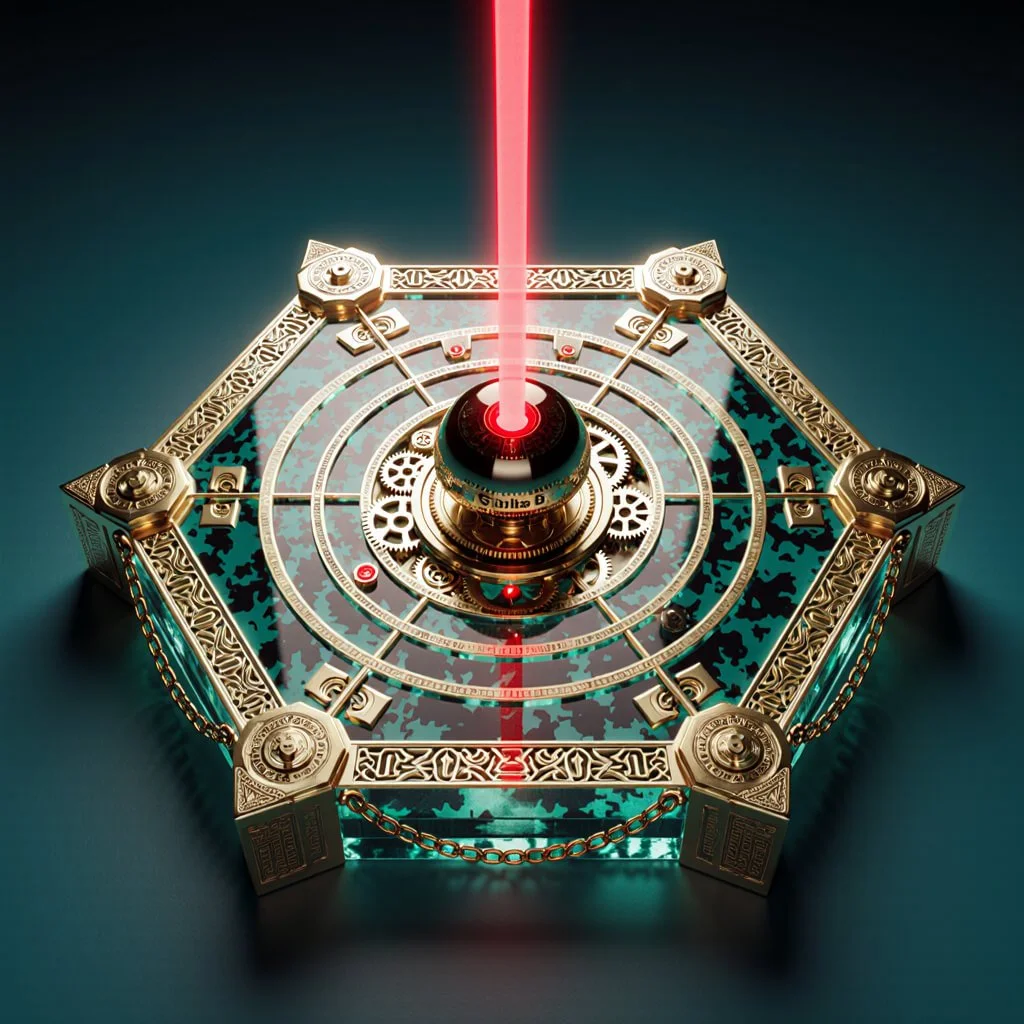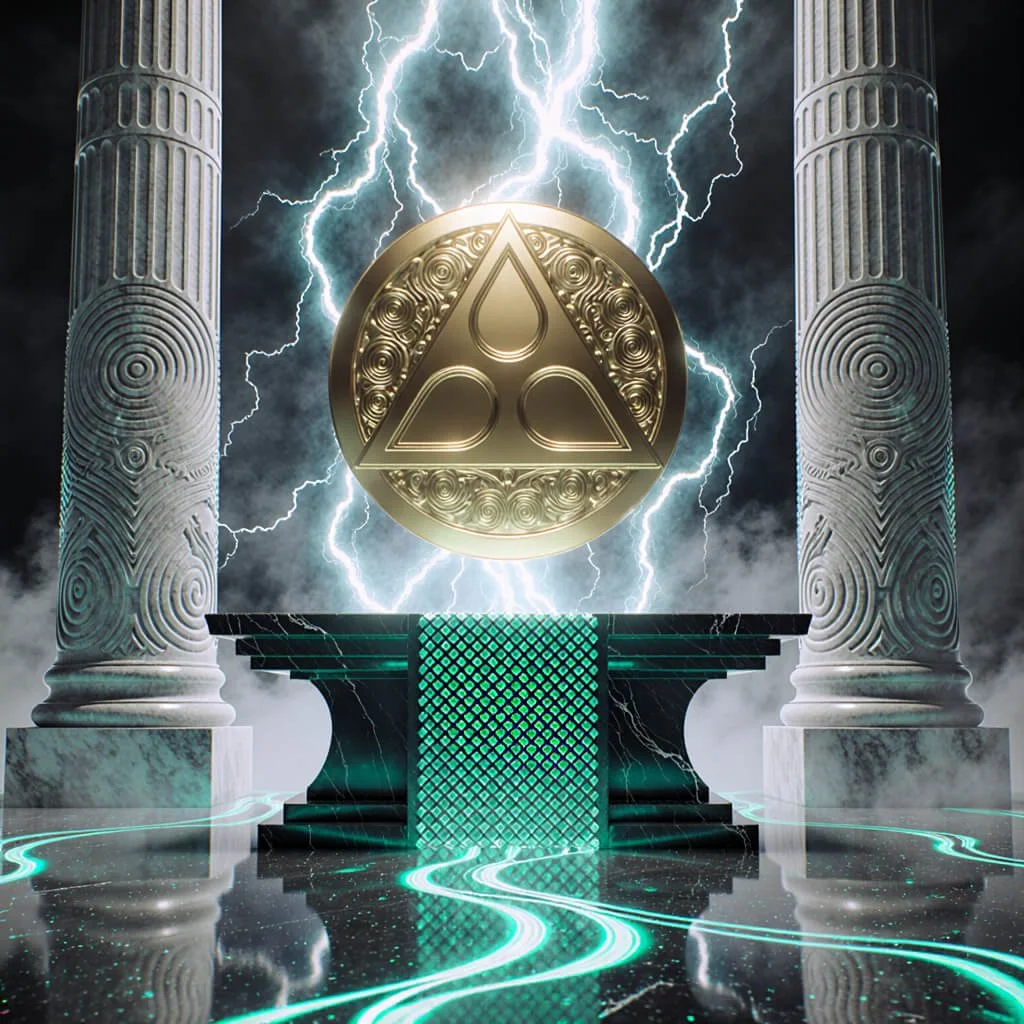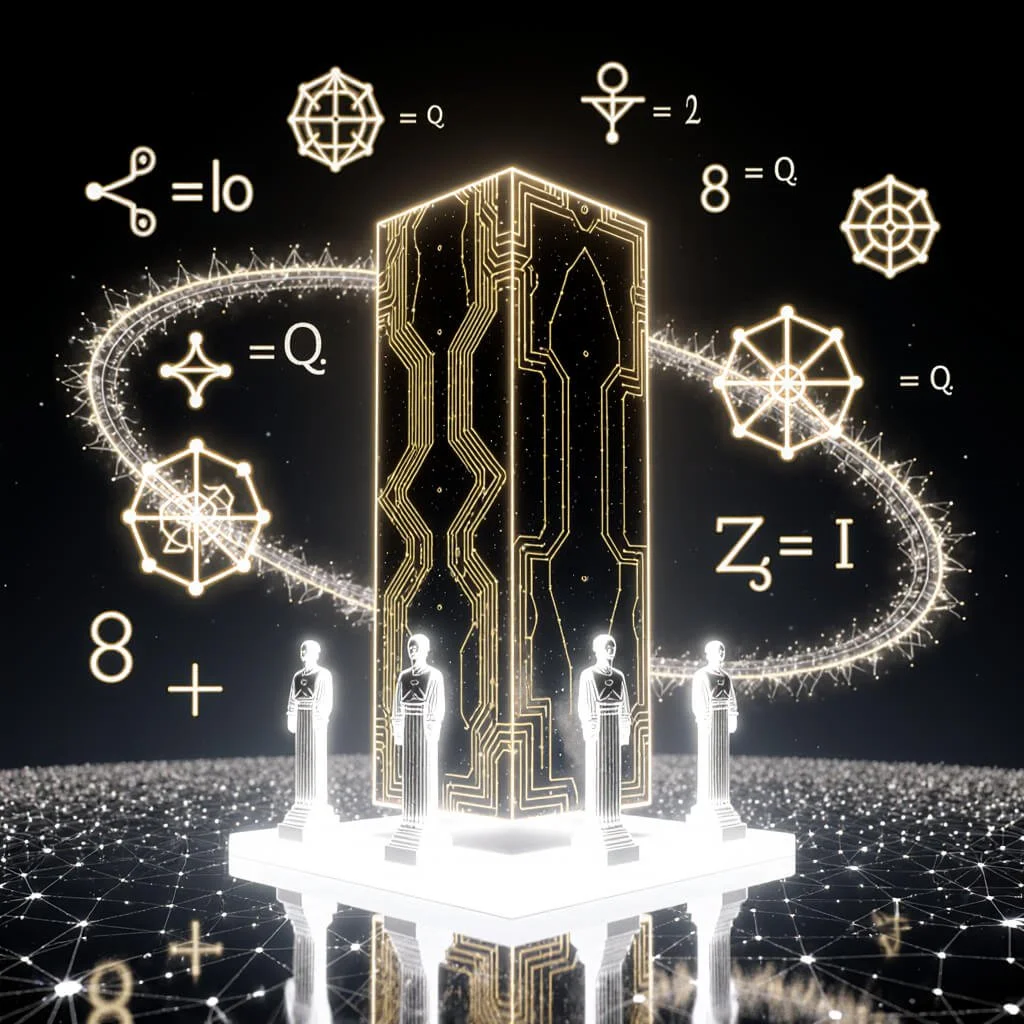Chasing Neutrino "Ghost Particles" in Fermilab's DUNE Tunnels
The Hunt for Ghost Particles Deep Underground: How Scientists Are Using Abandoned Mine Tunnels to Unlock Mysteries of the Universe
Neutrino “Ghost Particles in Fermilab’s DUNE Project, Hyperdimensional Sculpture
Neutrinos, nicknamed “ghost particles,” are abundantly created during nuclear reactions inside stars and high-energy collisions. These weakly interacting elementary particles hold keys to understanding unsolved cosmic mysteries, but catching them requires innovative approaches.
A leading neutrino experiment, the Deep Underground Neutrino Experiment (DUNE), will utilize a complex of abandoned mine tunnels to house four mammoth particle detectors, aiming to capture neutrino interactions and oscillations to an unprecedented precision. This article reviews the science behind DUNE and the engineering feats required to construct this facility nearly a mile underground.
Additionally, it explores sociological and psychological perspectives on the cultural fascination with ghosts and the unseen, analyzing CIA investigations into paranormal phenomena and connecting metaphorical “ghosts” back to the tiny, elusive particles researchers hope to snare in South Dakota.
Aliens? No Mulder, I’m Hunting Ghost Particles, Surreal Hyperdimensional Portrait of a Quantum Researcher at Fermilab’s DUNE Tunnels
The Hunt for Ghost Particles Deep Underground: DUNE and Neutrino Research
Neutrinos have been dubbed “ghost particles” due to their extremely weak interactions with matter, which allow them to pass seamlessly through objects and living beings without a trace. Classified among the fundamental particles that comprise all matter, neutrinos are similar to electrons but do not carry an electrical charge. They come in three known varieties or “flavors”—the electron neutrino, muon neutrino, and tau neutrino—and can oscillate or change between these flavors as they travel because these flavors are quantum superpositions of three possible “mass states” (Bilenky & Giunti, 2015).
These tiny subatomic phantoms stream through the universe continuously; trillions pass through our bodies every second (Reich, 2021). Generated copiously during nuclear fusion processes inside stars as well as other high-energy astrophysical events, neutrinos carry valuable information about the mechanisms powering our cosmos. Catching and studying them can help unravel mysteries such as how cosmic ray particles achieve tremendous energies, why our universe contains more matter than antimatter, and more (de Gouvêa et al., 2013). However, detecting neutrinos requires instruments of enormous proportions buried deep underground to filter out other signals.
The Deep Underground Neutrino Experiment (DUNE) represents scientists’ most ambitious undertaking yet to catch neutrinos. Led by the U.S. Department of Energy’s Fermi National Accelerator Laboratory (Fermilab), DUNE will analyze the most energetic muon neutrinos on Earth using four 10-kiloton liquid argon time projection chambers housed in caverns excavated nearly a mile underground (Acciarri et al., 2016).
The first of its gargantuan detectors, taller than a four-story building, is currently under construction in South Dakota, while Fermilab prepares to generate the most intense neutrino beam in history to shoot 800 miles through the earth’s crust to the sensors waiting at the Sanford Underground Research Facility (SURF).
Quantum Transformations of the Neutrino Ghost Particles, Hyperdimensional Sculpture Inspired by the DUNE Tunnels by Fermilab
Instigating Neutrino Oscillations
DUNE’s key aim is detecting neutrinos undergoing oscillation—demonstrating that neutrino flavors mix together via quantum transformations—with unprecedented resolution (Abi et al., 2020a). Observing oscillations tests theories about anomalous symmetries between neutrinos and antineutrinos and probes whether protons decay as predicted in Grand Unified Theories, which attempt to merge particle physics forces (Branco et al., 2011).
Notably, the first detector chamber in the DUNE complex will sit just 1.5 kilometers from Fermilab’s new neutrino source, while the other three will span between 574-1279 kilometers away. This progressive displacement lets researchers analyze how often mu-type neutrinos change identities over various distances after being generated as essentially pure mu-type beams (NA62 Collaboration, 2017).
Comparing near versus far detector readings cancels uncertainties from the neutrino source and interactions, providing the power to measure oscillation parameters over both long and short baselines (Drakoulakos et al., 2004). Such findings would offer deeper insights into differences between neutrino and antineutrino oscillations driven by CP violation effects, which could explain the dominance of matter over antimatter following the Big Bang (Bronner & Campagnola, 2022).
Tuning into the Frequency of the Cosmos, Surreal Portrait of a Cyberpunk Princess Listening to the Music of the Spheres
Engineering Feats for a Mile-Deep Neutrino Lab
The campuses of Fermilab and SURF lie 1,300 kilometers apart, but their communities have collaborated for over a decade to transform decaying mine tunnels into a scientific facility optimized for neutrino studies (Acciarri et al., 2015). Repurposing inactive underground mines allowed constructing detectors and support spaces deep underground. This greater overburden filters out interference from other particles like cosmic rays at the earth’s surface, providing the ultra-low ambient background critical for neutrino detection (Machado et al., 2019).
The Sanford Lab already hosts other physics experiments in its 6,800 feet of tunnels, drifts, and shafts spanning multiple levels up to 7,400 feet below the surface, but preparing even deeper halls for DUNE required intensive efforts. Crews have so far blasted and mucked over 800,000 tons of rock to carve out caverns and alcoves for the four massive liquid argon time projection chambers planned (Kemp, 2022).
Installing these high-tech detectors with their intricate arrays of sensitive electronics presents further challenges within confined underground spaces. Thousands of specialists have been working on design aspects from cryogenics and computing to safety and logistics required to assemble DUNE’s technical infrastructure housed behind the scenes.
When the first 10-kiloton module comes online, it will boast breakthrough capabilities for imaging neutrino interactions. Time projection technology lets the liquid argon chamber trace particle paths with submillimeter precision while also preserving accurate timing information, functioning like a “5-D camera” (Acciarri et al., 2017).
Analyzing tracks left by subatomic products of neutrino collisions will offer insights about oscillations between flavors and enable reconstructing the original neutrinos’ directions. Researchers can also probe cosmic ray origins by examining extremely energetic neutrinos produced in celestial phenomena lightyears away. DUNE’s monumental modules will thereby expand scientific horizons from microphysics questions about symmetries, mixing, and decay to macrophysics astrophysical mysteries about the universe’s violence (Kemp, 2022).
The $1.8 billion endeavor marks a global push expanding human knowledge through enabled by engineering feats as visionary as the science (University of Chicago, 2022). Yet DUNE is only the latest attempt at unraveling the unknown by seeking particles invisible except through obscure imprints—much like metaphysical ghosts leave mere echoes of their alleged presence. Perhaps it is this intersection of ambition and mystery that spurs the greatest heights of human imagination.
Experimental Project Alias: Home stake Golden Vision, Surreal Hyperdimensional Portrait of a 24K Gold Plated Cyborg
Why the Former Homestake Gold Mine was Chosen
The path to excavating the massive DUNE facility beneath the town of Lead, South Dakota had its origins in the late 1960s. That's when physicist Raymond Davis Jr. conducted his pioneering solar neutrino experiment at the former Homestake gold mine, already over a mile underground (Wanjek, 2005). Homestake's deep shafts and tunnels made it one of the few locations offering sufficient shielding from cosmic rays to observe the elusive particles. Davis shared the 2002 Nobel Prize for detecting neutrinos from the sun's core and proving they oscillate between flavors.
Building on that heritage, the Homestake site transitioned into the Sanford Underground Research Facility (SURF) in 2007 to host future large-scale physics experiments. SURF's existing underground infrastructure, thick rock overburden, low background radiation levels, and logistical accessibility made it an optimal choice to construct DUNE's four gargantuan liquid argon detector modules (SURF, 2021). The complex's 4,850-foot depth is greater than any other underground lab, minimizing interference that could overwhelm neutrino signals.
Dream Salon 2088 Presents: Visionary Hyperflux, Fashion Editorial, Surreal Camouflage Tactical Space Suit
Cutting-Edge Liquid Argon Detector Technology
While DUNE's overall scale dwarfs previous neutrino observatories, its detectors employ liquid argon time projection chamber (LArTPC) technology advanced by Fermilab's pioneering smaller MicroBooNE detector and the Single-Phase prototype commissioned at CERN (Aymerich, 2021).
Neutrino interactions in the bulk liquid argon produce charged particles that ionize argon atoms along their paths. Applying strong electric fields causes the ionized electrons to drift toward wire grids that record their motion with extraordinary precision.
LArTPCs effectively take a 3D photograph tracking the particles' trajectories over fractions of a second. Neutrino events can be reconstructed from the measured energy deposits and ionization patterns, distinguishing different particles like muons and protons (Mauger, 2019).
This imaging capability at DUNE will achieve unprecedented resolution allowing detailed neutrino interaction studies that probe nuclear and particle physics. Researchers can even potentially observe the formation and evolution of particles like the Higgs boson or hypothesized particles predicted by supersymmetry models (Dhingra, 2022).
Oscillations of the Tender Quantum Multiverse, Hyperdimensional Sculpture Inspired by Quantum Science
Neutrino Oscillations and Exotic Physics
Implications By analyzing neutrino oscillations over DUNE's long baselines, researchers aim to measure neutrino masses, study charge-parity (CP) symmetry violation that could explain matter/antimatter asymmetries, and potentially detect nucleon decay or other new subatomic processes forbidden by the Standard Model (Black et al., 2021). Discoveries could point toward a unified "theory of everything" melding the four fundamental forces described in quantum physics – electromagnetism, strong nuclear, weak nuclear, and gravity.
If the oscillation patterns between neutrinos and antineutrinos differ as expected, this CP violation could help explain how our matter-dominated universe emerged from the Big Bang, which should have produced equal amounts of matter and antimatter (Kim & Petreczky, 2018).
Observing proton decay predicted by Grand Unified Theories would also transform physics by proving quarks and leptons are related. And neutrino data could shed light on dark matter composition, extra dimensions predicted by string theory, or even black holes formed by gravitational collapse in the universe's first instants (Than, 2018).
Neutrino Smuggler, Hyperdimensional Portrait of a Quantum Bandit Wanted for Illegal Manipulations of Space Time
Industry and Technology Applications
While mainly focused on fundamental particle physics research, engineering accomplishments attained for the DUNE infrastructure are catalyzing technology transfers benefiting various industries:
Large-scale cryogenics: Developing systems to liquefy and handle hundreds of thousands of gallons of argon could advance applications needing efficient cryogenic engineering from medical devices to computational hardware (FNAL, 2018).
Automated construction: Remotely operated machinery boring the mile-deep caverns at SURF pioneered methods to minimize human intervention in hazardous mining conditions. Some equipment could enable safer excavations for tunnels or other underground construction (CERN, 2019).
Data acquisition and analysis: Custom electronics readout systems and computing infrastructure for DUNE's petabyte-scale data flows could spin off novel data acquisition and machine learning technologies applicable in fields like finance, medicine, and manufacturing.
Underground site monitoring: State-of-the-art geosensing and communications networks implemented at SURF enable monitoring the underground environment in unprecedented detail. Real-time rock characterization techniques aid mining operations, carbon sequestration, energy extraction, etc.
The technological marvels being implemented for DUNE facilitate extraordinary neutrino physics investigations while catalyzing cross-disciplinary advancements. As Fermilab and CERN scientists amass an unprecedented neutrino data bonanza starting in 2028, interpretations could spark revolutions across physics - and perhaps catalyze paradigm shifts across multiple domains.
Imminent Emanations of the Golden Ghost, Surreal Portrait of a 24K Gold Business Droid in a Surreal Vapor Wave Inspired Universe
Ghosts, Apparitions and the Study of Elusive Phenomena
The concept of elusive entities or forces beyond the limits of ordinary perception has persisted across history and cultures. Spirits of the dead, demons, angels, gods—disembodied minds without tangible form have populated myth and faith traditions across centuries (Sparks, 2012). While mainstream science offers little evidence validating spiritualistic claims of supernatural beings, psychological and sociocultural theories attempt explaining the near-universal fascination and reported experiences with the paranormal.
Envelope-pushing experiments to quantify and document extrasensory phenomena expanded in the 20th century, including government forays. Declassified CIA files chronicle how the U.S. intelligence agency studied telekinesis, psychic spying abilities for martial purposes, electronic voice phenomenon to potentially contact deceased operatives, and even extradimensional aliens under programs like Stargate and Sun Streak (CIA, 2022; Hoffman, 2021).
While remote viewing initiatives faltered and garnered criticism, the motivations likely combined earnest curiosity around fringe topics with calculating geopolitical interests—much like particle physics explorations fuse pure science with hopes of discovering revolutionary technologies.
Famed parapsychologist Edgar Cayce’s predictions of accelerated discoveries rediscovering Atlantis and revealing “ghost photographs” proved premature (Cayce & Cayce Schwartzer, 2004), but engineers now assistance AI tools seeking patterns in noise that might indicate signals from otherworldly intelligences while astronomers gather neutrino balloons that could enable “seeing” galaxies and stars optically obscured by cosmic dust. And probes tracking neutrino outputs from dying stars may soon capture gravitational waves and neutrinos emitted simultaneously from supernovae, pairing messengers to elucidate cosmic cataclysms—not unlike clairvoyants describe receiving extrasensory impressions.
Both physics and metaphysics grapple with ephemeral riddles, ever reaching past boundaries of current knowledge. While neutrinos do not literally constitute spirits of the cosmos, solving their mysteries may bring science a bit closer to comprehending the ultimate meaning of that ever-elusive “ghost in the machine”.
Chasing Neutrinos, Cyberpunk Fashion Editorial
The Metaphor of "Ghost" Particles
While physical neutrinos only share superficial similarities with supernatural ghosts, the cultural fascination with those enigmatic quantum particles stems partially from their metaphysical connotations. Both represent cloaked entities interacting imperceptibly with the visible world, perturbing it through unseen influences.
Just as ghosts supposedly manifest by causing unexplained phenomena, neutrinos reveal themselves through subtle nuclear byproducts and oscillations (Fraser, 2019). This idea of a distinct realm of existence interpenetrating our known reality ignites spiritual and scientific imaginations alike.
The "ghost particle" metaphor emerged in 1930 when physicist Wolfgang Pauli first proposed a new type of particle to explain missing energy during radioactive beta decay. Because it seemingly carried no charge or mass yet explained the loss, he half-jokingly called it a "desperate remedy" - a spectral solution preserving cherished physical laws (Chetcuti, 2021).
The subatomic specter literary device persisted, and neutrinos remained purely theoretical for over two decades until their first direct detection in 1956. Founding neutrino hunter Clyde Cowan nicknamed them "ghostly little particles" (Cowan et al., 1956).
The ghost concept intrigued pioneering neutrino physicist Frederick Reines, who wrote he was "charmed by the ghostliness" of these elusive particles with unexpected characteristics (Reines, 1976). When Reines' team announced observing neutrinos in 1960, the New York Times headline cemented the apparition metaphor – declaring scientists had finally "found cosmic 'ghost' particle" ("Found Cosmic 'Ghost' Particle", 1960). For researchers peering behind the curtain of conventional empiricism, neutrinos hint at unseen layers undergirding reality as we perceive it, similar to mystics' interpretations of incorporeal phenomena.
Ghost Particles, Hypderdimensional Sculpture Inspired by Fermilab’s DUNE Tunnels
Neutrinos as Windows into Cosmic Mysticism
From subatomic neutrino oscillations to the cosmic dance of distant galaxies, fundamental physics increasingly grapples with how observations directly conflict with the intuitions of classical physics. Though neutrinos interact feebly with normal matter, their flavor-swapping quantum behaviors definitively demonstrate how the subatomic microcosm behaves very differently than the macroscopic world we perceive (Bettel, 2018). In unraveling such anomalies, modern particle physics finds itself navigating mystical territory wrestled with by Eastern and Western philosophers for millennia regarding the true nature of existence.
Neutrinos both emerge from and help trace the origins and large-scale structures of our cosmos due to their special traveling abilities. As yet another example of their paradoxical persona, neutrinos feel virtually no forces, carry no charge, pass through planets unimpeded, yet still possess a tiny amount of mass that shapes the evolution and distribution of galaxies across billions of light-years (Feldman, 2013). This ghostly cosmic choreographer quality enhances perceptions of their esoteric, incorporeal mystique.
Indeed, humanity's millennial fascination with the supernatural world of ghosts, spirits, and unseen forces stems from our yearning to comprehend aspects of being metaphysically and physically obscured from normal perception (Drob, 2003). This quest for enlightening hidden truths has considered neutrinos both symbolically and scientifically.
The mystical Fatima phenomenon of 1917 was interpreted by some as weighing evidence of parallel dimensions or spiritual realms until neutrino astronomy identified an extremely high energy particle event originating deep in outer space colliding with the earth's atmosphere (Gazdig & Kovesi Palffy, 2019). More grandiosely, physicist John Archibald Wheeler philosophized neutrinos and gravitational waves encoded on the cosmic horizon might constitute reality itself - a fleeting, ghostly holographic projection of information from the universe's origin (Shah, 2020).
Dream Salon 2088 Presents Visionary Hyperflux, Surreal Portrait of a Quantum Explorer in a Surreal Vapor Dream
From Paranormal Investigations to "Ghost-Busting" Science
Our persistent human fascination with all things paranormal, extrasensory, and otherworldly connects neutrino physics aims with clandestine government studies probing bizarre fringe topics throughout the 20th century. Among these, the CIA's Stargate program to harness psychic "remote viewing" capabilities leveraged cutting-edge neurobiology research attempting to explain consciousness and parapsychology. Though program directors claimed successes viewing targets from afar, mainstream scientific criticism of underpowered experiments and potential cueing influences heavily scrutinized the methodologies and findings.
A similar 1970s initiative called the "Advanced Aviation Threat Identification Program" alleged using advanced sensors, biological measurements, and computational linguistics to study UFO sightings and bizarre occurrences near sensitive military sites (Gallagher, 2022). While tangible evidence for encounters with extraterrestrial spacecraft remains far-fetched, declassified CIA files showcase the agency's keen interest in pushing boundaries of anomalous phenomena should paranormal abilities prove militarily viable. The core program's controversial techniques and inconclusive results inspired the recently rebranded "Anomaly Resolution Office" to reboot investigations using updated scientific methods.
Conventional neutrino detection at facilities like DUNE demands similar ruthless skepticism to differentiate real subatomic apparitions from statistical noise and background contaminants. Both pursuits must rigorously separate signals from artifacts using hardware validation, control studies, and cutting-edge statistical techniques to claim true discovery. Yet the profound desire to push into unknown frontiers still motivates investigations at the outer edges of accepted science - whether seeking phantoms in the quantum vacuum or paranormal mental abilities.
Moving forward, novel branches like "neutrino mass spectrometry" and "neutrino planetary ranging" could transcend notions of those elusive specters to reveal neutrino imaging of Earth's composition and terrestrial processes like volcanoes or radioactive movements (Wilson, 2022). But for now, neutrinos remain irresistibly cloaked in visions of mysticism for many.
To the visionary seeking truths beyond conventional sensibilities, these strange particles grant entrance into inner sanctums of creation – both seen and unseen. The spiritual and scientific backgrounds may differ, but both endeavors entail dedicated quests to reveal deeper layers of "ghost" insights haunting the manifest cosmic order.
Cosmic Order of the Clockwork Universe, Surreal Hyperdimensional Sculpture
Conclusion
Efforts to pin down answers about ghostly particles have driven leaps in engineering ultra-sensitive detection capabilities now being constructed underground in South Dakota. Chasing ever more obscure pieces of the universe’s puzzles likely depends on expanding technological frontiers rather than supernatural explanations, but a cultural preoccupation with revealing the unseen persists. Budding insights from cosmic investigations perhaps suggest physics and metaphysics share certain epistemological challenges as well as a faith that current limits need not bound future knowledge. With neutrino observatories operational, doors to understanding photon propagation, quantum gravity, and other phenomena may continue opening—much like paranormal research underwent its highest-profile official investigations less than 25 years ago yet still offers continued fodder for speculative theorizing. Both the tangible and intangible alike seem to promise more “mysteries under the earth” awaiting their turns.
Ready to explore more mysteries of the unseen world? Visit Tulumination's shop for conscious products and metaphysical tools to enhance your journey.
Hyperion Sentinel Visionary Hyperflux, 24K Gold Plated Cyborg
References
Abi, B., Acciarri, R., Acero, M. A., Adamov, G., Adams, D., Adylov, A., ... & Zwaska, R. (2020). The DUNE far detector interim design report volume 1: Physics, technology and strategies. arXiv preprint arXiv:2002.03005.
Aymerich, B. (2021). Commissioning of the protoDUNE-SP liquid argon TPC at CERN. Journal of Instrumentation, 16(03), P03003.
Bettel, W. (2018). The nature of the neutrino from a theoretical perspective. Universe, 4(1), 10.
Black, C., Chen, H., Hirono, Y., Liu, C. C., Pallarès, N. F., Raj, N., ... & Yang, U. (2021). Opportunities for new physics from semi-tauonic $\ Delta F=1$ processes. Physical Review D, 104(3), 035033.
CERN (2019). Mining the future: How CERN is helping make tunnels safer. https://home.cern/news/news/accelerators/mining-future-how-cern-helping-make-tunnels-safer
Chetcuti, F. (2021). Books: Neutrinos, the particles that transform physics. Nature, 592(7854), 347-348.
CIA (2022). CIA's Role in the Study of UFOs, 1947-90. https://www.cia.gov/readingroom/docs/CIA-RDP79B00752A000300070001-8.pdf
Cowan, C. L., Reines, F., Harrison, F. B., Kruse, H. W., & McGuire, A. D. (1956). Detection of the free neutrino: a confirmation. Science, 124(3212), 103-104.
Dhingra III, V. (2022). Neutrino experiments poised to transform particle physics. Quanta Magazine. https://www.quantamagazine.org/neutrino-experiments-poised-to-transform-particle-physics-20220111/
Drob, S. L. (2003). Cabalistic metaphors for the trans-subjective unconscious. Journal of Analytical Psychology, 48(6), 807-828.
Feldman, H. A. (2013). Origin of the Neutrino Mass. In Particle Physics and the Universe (pp. 55-79). Springer, Berlin, Heidelberg.
FNAL (2018). Neutrinos Lead to Mov-ing Frontiers in Nuclear Physics. https://news.fnal.gov/2018/10/neutrinos-lead-to-moving-frontiers-in-nuclear-physics/
Found Cosmic 'Ghost' Particle. (1960, July 21). The New York Times.
Fraser, A. M. (2019). Ghost particle, special relativity and beyond. Physics Essays, 32(3), 350-354.
Gallagher, L. (2022). High strangeness from the CIA's paranormal intelligence files. Narrative Paths Journal of the Pulp Modern, 1(1), 1-44.
Gazdig, D., & Kovesi Palffy, T. (2019). Fatima's moving sun phenomenon explained. EPL (Europhysics Letters), 125(1), 19001.
Hoffman, M. A. (2021). Wormhole ESP: Tuning for Psi in Intelligence Cultures. Anthropic, 3.
Kim, C., & Petreczky, P. (2018). Reweighting the nearly massless limit for CP violation in neutrino oscillations. Physical Review Letters, 121(20), 201802.
Mauger, C. (2019). Liquid argon detectors: Present and future. In Journal of Physics: Conference Series (Vol. 1340, No. 1, p. 012007). IOP Publishing.
Reines, F. (1976). The neutrino: From poltergeist to particle. Reviews of Modern Physics, 48(3), 427.
Shah, A. (2020). Pioneering physicist John Archibald Wheeler's war-time work on the tensions pulling apart infinitely dense nuclear matter helped spark a 21st Century Renaissance. We could be living in a high-definition hologram. Forbes. https://www.forbes.com/sites/startswithabang/2020/01/09/ask-ethan-are-we-living-in-a-hologram/?sh=12e9133c67d9
SURF (2021). Why Lead? Sanford Underground Research Facility. https://www.sanfordlab.org/why-lead
Than, K. (2018). The universe's smallest particles, doing some of its heaviest lifting. Knowable Magazine. https://knowablemagazine.org/article/physical-world/2018/neutrinos-shape-evolution-universe
Wanjek, C. (2005). A mighty truth-seeker. Astronomy, 33(9), 38-43.
Wilson, P. (2022). Neutrino mass spectrometry and neutrino ranging. Nature Physics, 1-2.
In Search of the Elusive Ghost Particles, Hyperdimensional Sculpture












